
This study evaluates user experiences in Virtual Reality (VR) and Mixed Reality (MR) systems during task-based interactions. Three experimental conditions were examined: MR (Physical), MR (CG), and VR. Subjective and objective indices were used to assess user performance and experience. The results demonstrated significant differences among conditions, with MR (Physical) consistently outperforming MR (CG) and VR in various aspects. Eye-tracking data revealed that users spent less time observing physical objects in the MR (Physical) condition, primarily relying on virtual objects for task guidance. Conversely, in conditions with a higher proportion of CG content, users spent more time observing objects but reported increased discomfort due to delays. These findings suggest that the ratio of virtual to physical objects significantly impacts user experience and performance. This research provides valuable insights into improving user experiences in VR and MR systems, with potential applications across various domains.
Yoshihiro Banchi, Yusuke Ohira, Mahiro Ito, Takashi Kawai, "Comparative Analysis of User Experience in Virtual Reality (VR) and Mixed Reality (MR) Systems Using Eye-Tracking Measurements" in Electronic Imaging, 2024, pp 353-1 - 353-4, https://doi.org/10.2352/EI.2024.36.2.SDA-353
 Find this author on Google Scholar
Find this author on Google Scholar Find this author on PubMed
Find this author on PubMed